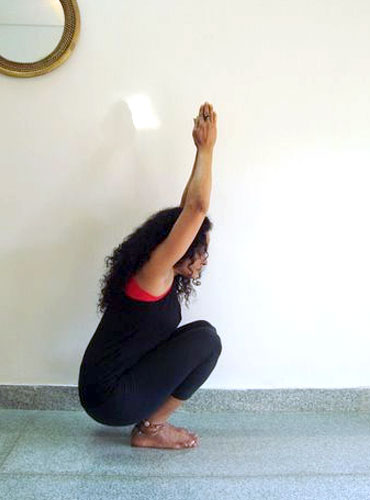Shameem Akthar
Yogic squats are very demanding. They demand flexibility and strengthen complete musculoskeletal co-ordination.
They can be used as warm-ups to prepare the body for more demanding poses. Or, they may be used as static strengtheners, where you hold each squat for a long duration for 30 seconds or more to build stamina, strengthen and tone your body.
Mental focus and determination is also acquired naturally when you practice yogic squats, whether it is done dynamically or statically.
Important: Avoid squats if you have chronic knee problem.
On the following slides, Shameem Akthar, yogacharya trained with the International Sivananda Yoga Vedanta Center, shows you five squats to tone your body and build your mental and physical stamina superbly.For more of Shameem's yoga writings visit http://jaisivananda.blogspot.com. Follow Shameem's yoga products on her online shop Yogatique on . Shameem's second book Yoga in the workplace, with photographs by ace photographer Fawzan Husain, is now available at online shops and bookshops across the country.
Disclaimer: This column just shares the columnist's passion for yoga which is ideally learned under the guidance of an expert.
Utkatasana (Squat or pose)
Stand with feet apart, toes pointed ahead. Inhale, going up on your toes. Simultaneously stretch out hands in front, at shoulder level.
Exhale, squatting so your hips reach down, to rest on your raised heels. You must remain on your toes.
Look straight ahead and focus to maintain your balance. Then bring knees gently together. Hold for ten seconds or so. Continue normal breathing. Then inhale, and slowly stand up.
Exhale, to drop heels back on ground. Repeat thrice. Later just do once, but hold for longer.
Important: Avoid, if you have knee problem. Ensure you are not tilting forward.
Benefits: Builds mental and physical stamina. Makes you flexible. Strengthens ankles and shin. Tones the entire body. Prevents and heals spinal problems, especially the lower back. Helps lose weight. Is preventive and therapeutic in diabetes and blood pressure also.
Utkatasana (Squat pose, 2nd variation)
Stand straight. Feet must be together. Stretch hands out at shoulder level. Inhale.
Exhaling, keeping torso straight, lower hips as shown in the picture on the left. Knees must also be together. Hold the pose, going only as low as is comfortable without tilting forward. Continue normal breathing.
Return to standing position, inhale. Repeat thrice. After a few weeks, you may hold it just once, for up to 30 seconds.
Important: Avoid, if you have knee problem.
Benefits: Same as the previous pose, but more enhanced.
Natrajasana (Dancing Shiva pose)
Stand straight. Feet about two feet apart, toes slightly flared out. Inhale, go up on toes, lifting hands up over head, as shown in the picture on the left.
Exhale, lower hips lightly, so you are squatting. Hold the pose steadily, breathing continuously, for ten seconds. Release pose with an inhalation. Repeat thrice.
Important: Avoid, if you have knee problem. Ensure you are not tilting forward.
Benefits: Tones up legs, and back. Improves focus.
Kali asana (Goddess pose)
Squat as shown in the picture, feet flat on ground. Spread knees. Fold arms at elbows to place palms together. Look ahead, breathing continuously. Hold for as long as it is comfortable.
If unable to fully squat, you may remain on toes initially. Then slowly, after a few weeks, start putting feet flat on ground.
Important: Avoid, if you have knee problem.
Benefits: Creates flexibility throughout the body. Strengthens the back. Develops focus. Therapeutic in urogenital problems.
Druta Utkatasana (Dynamic squat pose)
Stand straight. Feet should be together. Stretch arms overhead. Inhale.
Exhaling, begin to squat down, till hips almost reach the ground. Ensure balance. Move hands back to ensure body is not tilting forward. Hold, breathing normally.
To release pose, inhale, standing back up to starting position. Repeat a few times. Try to hold the final pose longer, with regular practice.
If unable to fully squat, you may remain on toes initially. Then slowly, after a few weeks, start putting feet flat on ground.Ensure body is not tilting forward. If having difficulty initially, stay on your toes.
Benefits: Prevents back pain, especially lower back. Increases overall flexibility. Makes the face glow. Tones entire body. Reduces fat. Boosts gut health. Develops mental stamina.







Comment
article